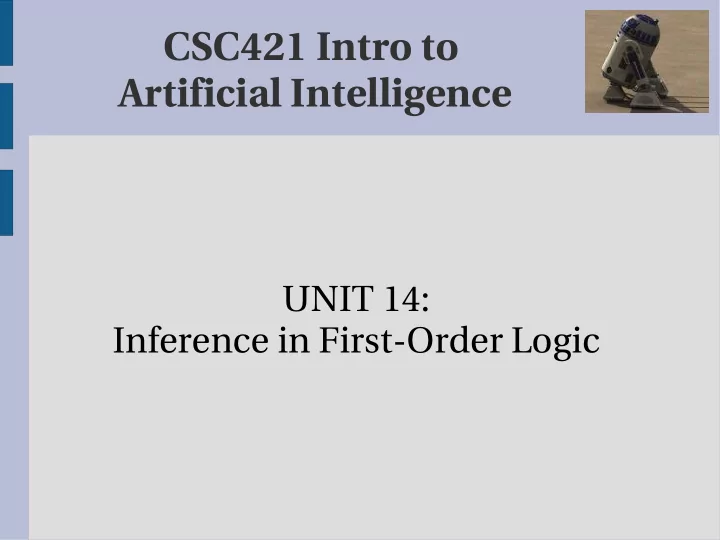

CSC421 Intro to Artificial Intelligence UNIT 14: Inference in First-Order Logic
Outline ● Generalized Modus Ponens ● Forward and backward chaining ● Resolution ● Logic Programming
Unification ● We can get the inference immediately if we can find a substitution θ such that King(x) and Greedy(x) match King(John) and Greedy(y) ● Θ = {x/John, y/John} works ● Unify(a,b)= θ if a θ = b θ
Unification examples P Q θ ? Knows(John, x) Knows(John, Jane) Knows(John, x) Knows(y, Bob) Knows(John, x) Knows(y, Mother(y)) Knows(John, x) Knows(x, Bob) Knows(John,x) Knows(y,z) Most general unifier Knows(John, z) rather than Knows(John, John)
Generalized Modus Ponens p 1 ', p 2 ', ....p n ' (p 1 ∧ p 2 ∧ . . . p n => q) q θ where p i ' θ = p i θ for all i p 1 ' is King(John) p 1 is King(x) p 2 ' is Greedy(y) p 2 is Greedy(x) θ {x/John, y/John} q is Evil(x) q θ is Evil(John) GMP is used with KB of definiteclauses (exactly one positive literal) All variables are assumed universally quanitifed.
Example knowledge base ● The law says that it is a crime for an american to sell weapons to hostile nations. The country Nono, an enemy of America, has some missiles, and all of its missiles were sold to it by Colonel West, who is American ● Prove that Colonel West is criminal
Example ● It is a crime for an american to sell weapons to hostile nations: – American(x) ∧ Weapon(y) ∧ Sells(x,y,z) ∧ Hostile(z) => Criminal(x) ● Nono has some missiles – Owns(Nono, M1) and Missile(M1) ● All of it's missiles were sold by Colonel West – Missile(x) ∧ Owns(Nono, x) => Sell(West, x, Nono) ● Missiles are weapons – Missile(x) => Weapon(x) ● An enemy of America counts as hostile – Enemy(x, America) => Hostile(x)
Example ● West is American – American(West) ● The country Nono an enemy of America – Enemy(Nono, America)
Forward Chaining Proof
Forward Chaining Proof
Forward Chaining
Properties of FC ● Sound & complete for FOL definite clauses ● Datalog = first-order definite clauses, no functions. FC terminates for Datalog in poly iterations ● May not terminate in general if a is not entailed ● Unavoidable: entailment with definite clauses is semidecidable
Backward Chaining
Backward Chaining
Backward Chaining
Properties of BC ● Depth-first recursive proof search – space is linear in size of proof ● Incomplete due to infinite loops ● Inefficient due to repeated subgoals ● Widely used for logic programming
Logic Programming ● Computation as inference in logical KB Logic Programming Ordinary Programming 1) Identify problem Identify problem 2) Assemble information Assemble information 3) Tea break Figure out solution 4) Encode info in KB Program solution 5) Encode problem instance Encode problem instance as facts as data 6) Ask queries Apply program to data 7) Find false facts Debug procedural errors
Prolog systems ● Basis: backward chaining with Horn clauses + bells and whistles ● Widely used in Europe, Japan (5 th gen.) ● Program = set of clauses – head :- literal1,....,literaln – criminal(X) :- american(X), weapon(Y), sells (X,Y<Z), hostile(Z) ● Efficient unification, retrieval ● Depth-first, left-to-right BC ● Predicates for arithmetic X is Y * Z + 3 ● Closed world assumption (negation as failure)
Prolog examples ● DFS – dfs(X) :- goal(X). – dfs(X) :- succesor(X, S), dfs(S). ● Loops expressed as recursions ● Appending two lists to produce a third: – append([], Y, Y). – append([X|L], Y, [X|Z]) :- append(L, Y, Z). – Query: append(A,B, [1,2]) ? – A = [], B=[1,2] – A = [1], B = [2] – A = [1,2], B = []
Resolution Full first-order version l 1 ∨ l 2 ∨ . . . ∨ l k m 1 ∨ m 2 ∨ . . . ∨ m n (l 1 ∨ l 2 ∨ l i-1 ∨ l i+1 . . . ∨ l k ∨ m 1 ∨ m 2 ∨ m j-1 ∨ m j+1 . . . ∨ m n ) θ Where UNIFY(l i , ¬ m j )= θ Apply resolution steps to CNF(KB ∧ ¬ α) ; complete for FOL
Resolution Example ● ¬ Rich(x) ∨ Unhappy(x) Rich(Ken) ● Unhappy(Ken) with θ = {x/Ken} ● Conversion to CNF – Eliminate biconditionals and implications – Move negations inwards – Standarize variables – Skolemize – Drop universal quantifiers – Distribute ∧ over ∨
Recommend
More recommend